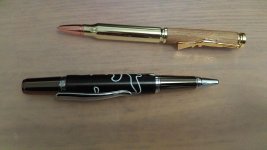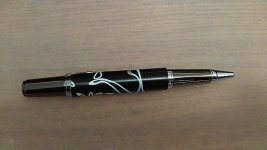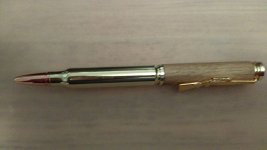alpha1
Fellow
I am brand new to this I made a bullet pen that turned out OK. This fired me up to have another go. Up to now I have spent a few bob on gouges kits tooling etc so I thought it was time to make some pens and see the results of my out lay. I cut and drilled several blanks.
Getting them square and drilling the holes central proved a bit of a challenge. I need a decent drilling jig. I glued and inserted the tubes and left the whole thing to cure overnight. The next day I chucked the blank trimmer in my lathe and attempted to trim them without much luck. I moved the trimmer to the mill that works better.
I assembled the first set of blanks on the lathe using a mandrel and bushings and set to with my new gouges. I gave up after ten minutes fitted a carbide cutter to my tool post and turned the blank using my conventional carbide tool holders. I screwed up one set of acrylic blanks I machined them down to the bushings then switched to sanding. Unfortunately after very little sanding the brass tube showed through. So they went in the bin. The next one up was a set of wooden blanks all went well until I got to ambitious with my cutting depth and split one of the blanks.
At this point I left the shed had something to eat and a cup of tea and mulled over the whole mornings work that had not worked out as I had hoped.
I went back in the shed on the afternoon cleared everything away I had been working on and started again this time keeping in mind my earlier mistakes I actually succeeded in making a pen. I gave it to the wife she loves it. It's a scirocco. There is lot more to this pen making than meets the eye.
My biggest disappointment is the gouges I bought I can not get them to work on my lathe and have much more success with my original carbide inserts using my quick change tool post.
Getting them square and drilling the holes central proved a bit of a challenge. I need a decent drilling jig. I glued and inserted the tubes and left the whole thing to cure overnight. The next day I chucked the blank trimmer in my lathe and attempted to trim them without much luck. I moved the trimmer to the mill that works better.
I assembled the first set of blanks on the lathe using a mandrel and bushings and set to with my new gouges. I gave up after ten minutes fitted a carbide cutter to my tool post and turned the blank using my conventional carbide tool holders. I screwed up one set of acrylic blanks I machined them down to the bushings then switched to sanding. Unfortunately after very little sanding the brass tube showed through. So they went in the bin. The next one up was a set of wooden blanks all went well until I got to ambitious with my cutting depth and split one of the blanks.
At this point I left the shed had something to eat and a cup of tea and mulled over the whole mornings work that had not worked out as I had hoped.
I went back in the shed on the afternoon cleared everything away I had been working on and started again this time keeping in mind my earlier mistakes I actually succeeded in making a pen. I gave it to the wife she loves it. It's a scirocco. There is lot more to this pen making than meets the eye.
My biggest disappointment is the gouges I bought I can not get them to work on my lathe and have much more success with my original carbide inserts using my quick change tool post.




 I like the idea of turning the blank round before drilling in a three jaw chuck I will give that a go.
I like the idea of turning the blank round before drilling in a three jaw chuck I will give that a go.

